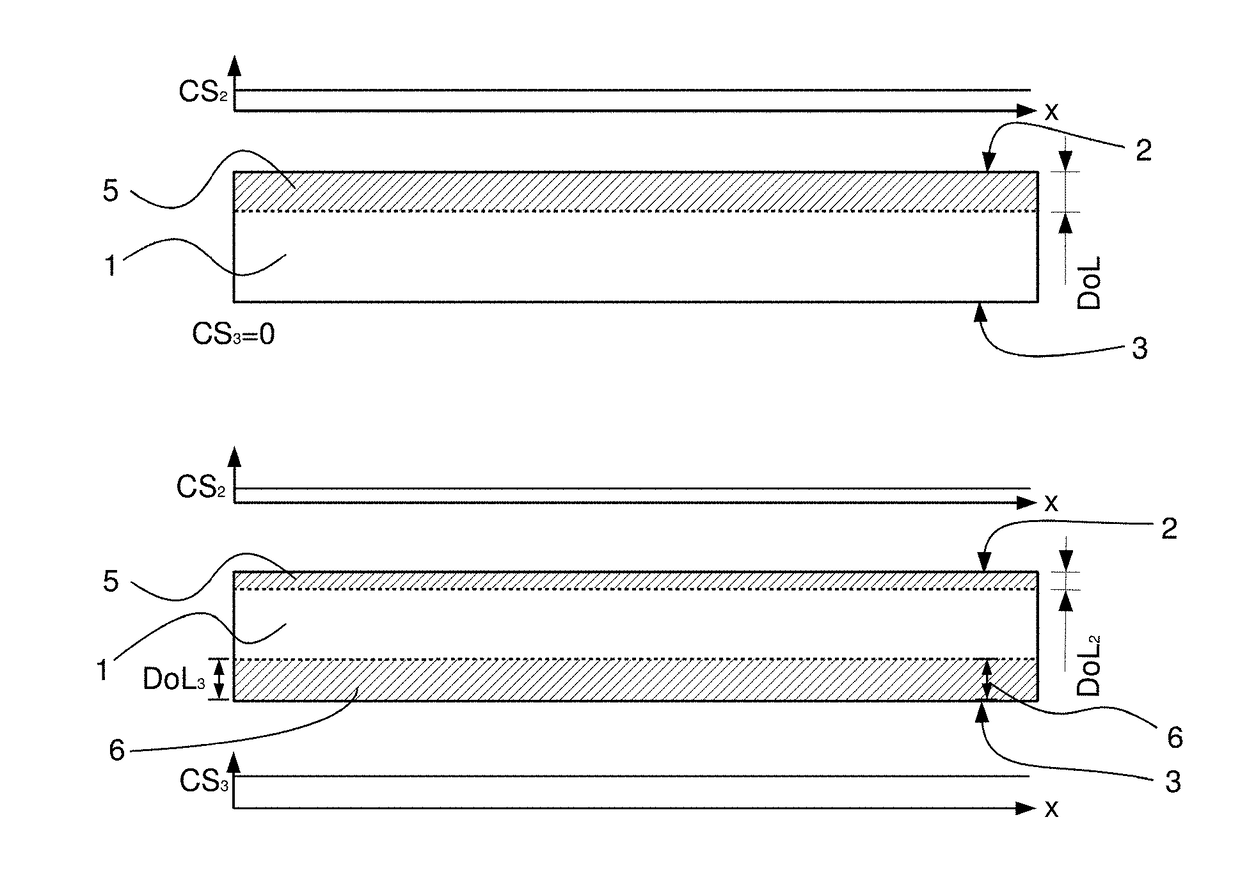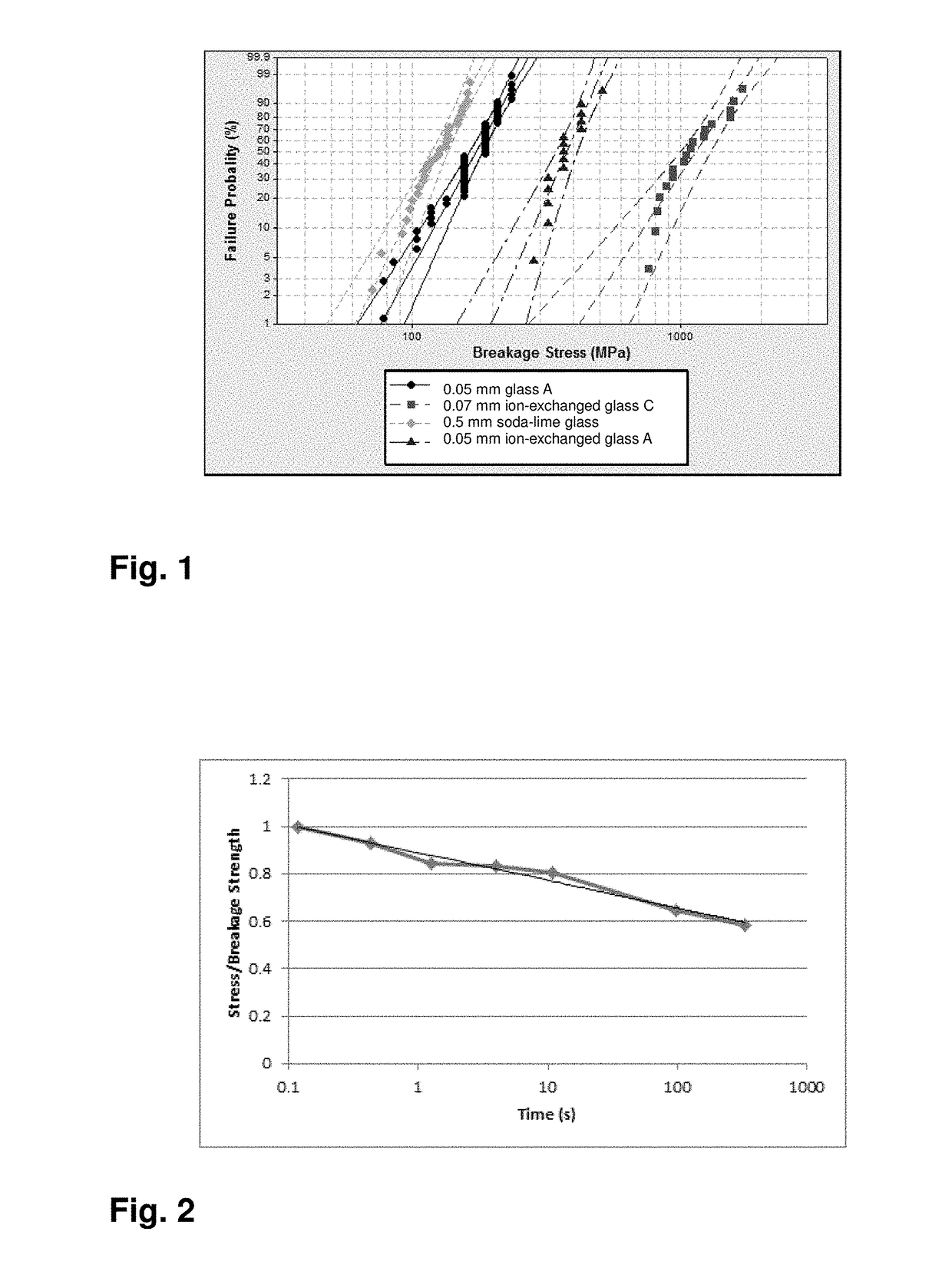Shaped glass article and method for producing such a shaped glass article
a technology of shaped glass and glass pieces, applied in the field of shaped glass pieces, can solve the problems of glass breaking, glass breaking, glass breaking during lamination, etc., and achieve the effects of reducing fatigue lifetime, high average breakage strength, and high surface resulting tensile stress
- Summary
- Abstract
- Description
- Claims
- Application Information
AI Technical Summary
Benefits of technology
Problems solved by technology
Method used
Image
Examples
example 1
[0114]A sheet of 100 mm×60 mm was cut from glass A (see Table 2) with a thickness of 0.05 mm. The glass sheet was pasted with an ink mixed with KNO3 powder by a screen printing method fully covering one of its surfaces. Subsequently, the sheet was dried at 180° C. during 1 hour to remove the ink. After drying, the sheet was annealed at 330° C. for 2 hours to drive an ion-exchange process. As a result, the ultrathin glass sheet experienced a bending into a widely cylindrical curved shape with a curvature radius of 52 mm.
example 2
[0115]A sheet of 100 mm×60 mm was cut from glass A (Table 2) with a thickness of 0.05 mm. The sheet was coated with an Indium Tin Oxide (ITO) film on one of its surfaces in order to prevent ion-exchange and was subsequently submersed into a KNO3 salt bath. The ultrathin glass sheet was toughened at a temperature of 400° C. for 1 hour. The CS is approximately 270 MPa and the DoL is approximately 7 μm. As a result, the ultrathin glass sheet experienced a bending into a widely cylindrical curved shape with a curvature radius of 48 mm.
example 3
[0116]A sheet of 100 mm×60 mm was cut from glass A (Table 2) with a thickness of 0.1 mm. The sheet was masked according to a regular stripe pattern. The sheet was then coated with an ITO-film, resulting in coated areas in order to prevent ion-exchange in the coated areas. After removing the masking, the ultrathin glass sheet was submersed into a KNO3 salt bath and toughened at a temperature of 400° C. for 1 hour. This resulted in an ion-exchange in the uncoated areas and in no ion-exchange in the ITO-coated areas. The CS is approximately 270 MPa and the DoL is approximately 7 μm. As a result, the ultrathin glass sheet experienced an alternating bending with several curved areas into a wave shape.
PUM
| Property | Measurement | Unit |
|---|---|---|
| thickness | aaaaa | aaaaa |
| minimal curvature radius | aaaaa | aaaaa |
| minimal curvature radius | aaaaa | aaaaa |
Abstract
Description
Claims
Application Information
 Login to View More
Login to View More - R&D
- Intellectual Property
- Life Sciences
- Materials
- Tech Scout
- Unparalleled Data Quality
- Higher Quality Content
- 60% Fewer Hallucinations
Browse by: Latest US Patents, China's latest patents, Technical Efficacy Thesaurus, Application Domain, Technology Topic, Popular Technical Reports.
© 2025 PatSnap. All rights reserved.Legal|Privacy policy|Modern Slavery Act Transparency Statement|Sitemap|About US| Contact US: help@patsnap.com



